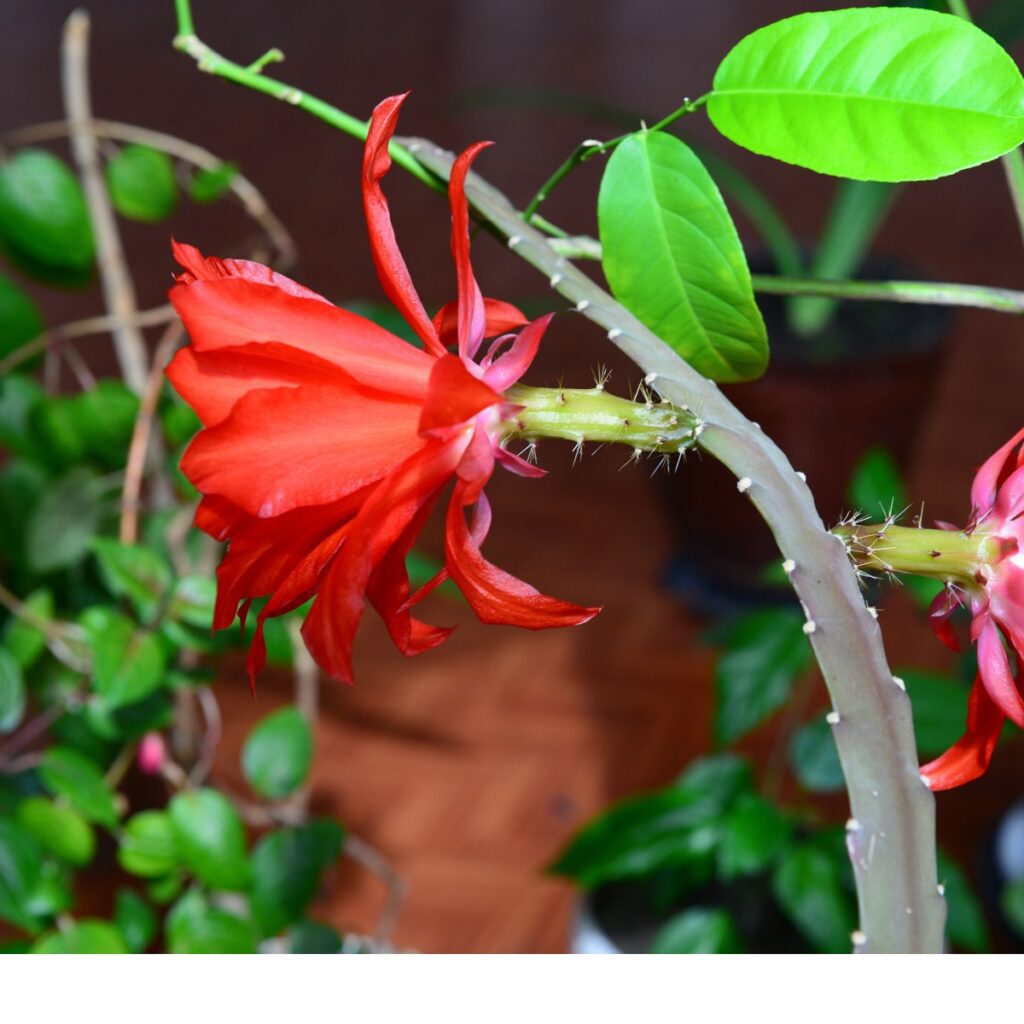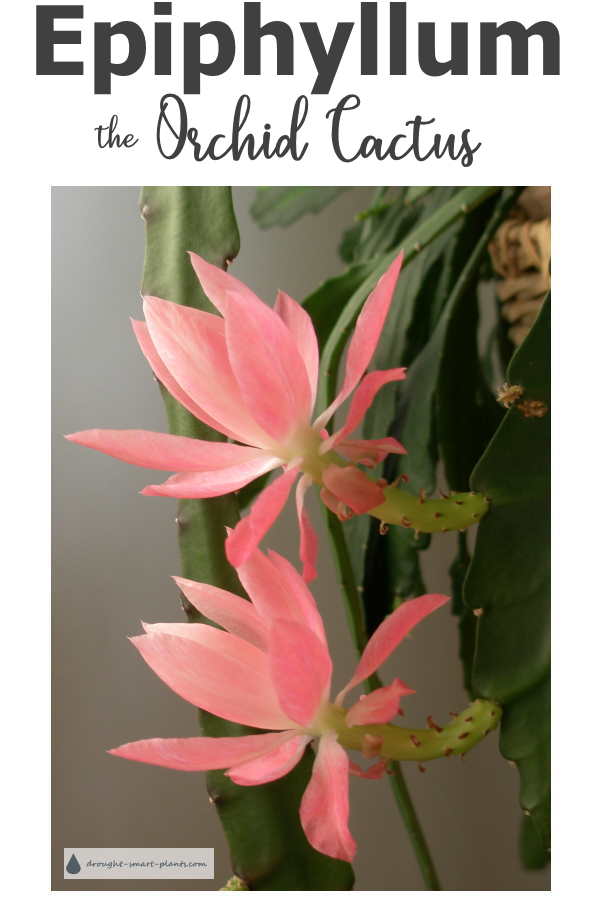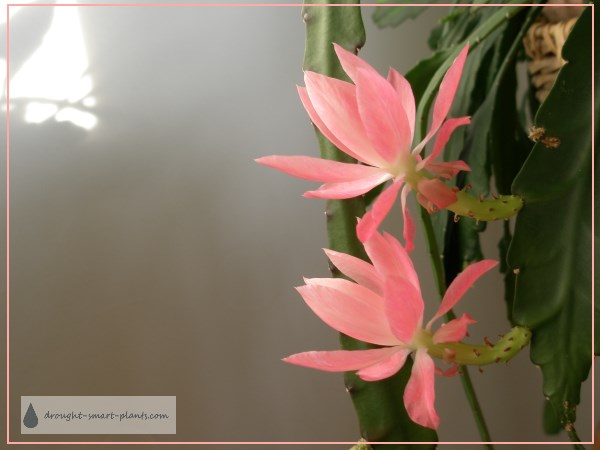
Epiphyllum, often called orchid cacti or climbing cacti, is a group of tropical succulents. There are more than twelve species, including some hybrids. These plants typically have long, flat stems without spines that trail down.
With proper care, they produce large, fragrant flowers that bloom at night in the spring or summertime. In their natural habitat, these mostly epiphytic plants grow on tree branches or trunks, drawing moisture and nutrients from the humid surroundings.

In a garden, the orchid cacti’s long stems can make hanging baskets look especially magical. Unlike regular cacti, they don’t thrive in full sun and dry air. Epiphyllums actually prefer warm, humid, and shaded environments, probably because wild orchid cacti grow in a forest environment.
This means that an orchid cactus would be a great choice for someone who’s growing and propagating their first cactus plant. They’re slow-growing, easy-to-care-for, and they look pretty awesome, too! In this guide, we’ll be telling you everything you need to know about growing, taking care of, and propagating your orchid cactus. Let’s get started!
Caring For Your Orchid Cactus
If you’re unable to provide your epiphyllums with gentle temperatures, filtered sunlight, humidity, and a loose potting mix, it’s better to keep them indoors. They thrive in conditions similar to orchids and bromeliads, so just keep that in mind!
If grown outside, they will need shelter from powerful winds and a good amount of air flow. For this reason, we’d really recommend that beginners raise their first orchid cactus as a houseplant. Here’s what you’ll need to keep in mind when it comes to taking care of your orchid cactus:
Light
Orchid cacti thrive in light that’s filtered, similar to the sunlight they’d get in their natural tropical forest homes. It’s okay for them to have a few hours of direct morning sunlight, but it’s best to keep them away from intense midday sun to prevent burning or damage. When they’re outside, hanging them in a basket under the shade of a tree is a good idea.
Avoid placing your epiphyllum in a room where the lights stay on for a long time after the sun sets, as this can affect their ability to bloom the next year. Too much light can lead to wilted leaves and yellowing. If they’re not getting enough light, they might grow tall and spindly, which isn’t ideal.
Water
Finding the right balance with watering is super important for your orchid cacti to grow well. Unlike typical cacti, they need regular watering during their active growth period. Make sure the soil is damp but not soaked.
It’s best if the top part of the soil dries out before watering again. During winter, water less and move the plant to a cooler spot. This will help it produce big, healthy flowers next season. Using distilled or filtered water, rather than tap water, is good for these delicate plants.
If the soil stays too wet, especially in colder temperatures, it could lead to branches dying off or rust spots appearing. If this happens, trim away the affected branches, replant in a dry, fast-draining soil, and be more careful with watering.
Soil
It’s not advisable to plant your epiphyllum directly in the ground because regular soil is too dense, and the roots won’t handle it well. This could ultimately lead to the plant’s demise. Instead, opt for a loose, quick-draining potting mix that includes light and porous materials. This will help the cactus drain more effectively.
When you use a loose potting mix, it allows the roots to breathe and prevents water from accumulating around them, reducing the risk of root rot. This is essential for the health and survival of your epiphyllum. Adding materials like perlite or orchid bark to the mix can help to create a well-aerated environment for the plant.
Choosing the right pot is just as important. Select a container with drainage holes to ensure that excess water can escape (this will prevent waterlogged soil as well). This approach mimics the natural habitat of epiphyllums, which typically grow on trees where water can easily flow away from the plant.
Temperature and Humidity
If you’re planning to grow epiphyllums outdoors, it’s a good idea to keep them in pots or hanging baskets. This way, when the weather gets cold, you can easily bring these delicate plants inside. They’re not built to withstand frost or temperatures below freezing. Protect them at all costs!
When you’re caring for your orchid cactus indoors, you might need to adjust its location depending on the season. During the warmer months, you’ll want to place it somewhere quite warm, preferably where temperatures reach around 90 degrees Fahrenheit. If you can find a spot with filtered sunlight, that’s also ideal.
In the winter, it’s going to be a bit more difficult to keep your orchid cactus alive. A cooler area away from heat sources like radiators and cold drafts will be the best place to put it.
Temperatures between 50 to 58 degrees Fahrenheit are ideal during this time of the year. When you notice buds forming for the blooms, move the plant back to a warmer spot to encourage flowering.
In order for your epiphyllums to stay healthy, they will need a humid environment. You can increase humidity by placing the pot on a tray filled with wet gravel — just make sure that the roots don’t sit directly in the water. Other options include misting the stems regularly or using a humidifier.
Fertilizer
Applying fertilizer to your epiphyllum a few times annually can help it grow well and produce more buds. Because these plants naturally grow in places with few nutrients, it’s important not to give them too much fertilizer.
Look for a balanced, slow-release formula with lower nitrogen levels, ideally below 10%. In early spring, using a 2-10-10 fertilizer can support healthy flower development without overwhelming the plant with nutrients.
How to Propagate Your Orchid Cactus
If your orchid cactus has grown big and strong, you might be interested in propagating it. Propagating an orchid cactus can be a bit tricky if you don’t know what you’re doing, but following these steps should help! Typically, this process takes about six weeks, so just keep that in mind.
Step 1: Cut Healthy Stem Section
Begin by selecting a healthy stem section that’s approximately 9 inches long. It’s a good idea to choose a longer cutting, since shorter cuttings may take longer to flower.
Step 2: Let the Cutting Dry
Allow the cutting to dry and fully callus. This usually takes about a week. This step is important to prevent rotting, so don’t skip it!
Step 3: Insert the Cutting Into a Fast-Draining Potting Mix
Once the stem has callused, insert the cutting vertically into a fast-draining cactus potting mix. You can add pumice or perlite to enhance drainage if you like. Make sure to bury at least the bottom 1.5 to 2 inches of the stem.
Step 4: Place the Pot in a Warm Area
Place the pot with the cutting in a warm area with dappled light. Avoid using a pot that’s too large, as orchid cacti prefer to be slightly rootbound.
Step 5: Mist and Gradually Increase Watering
At first, you’ll want to mist the cutting lightly. As roots begin to form, gradually increase watering, and make sure that the potting mix stays consistently damp. Maintain a temperature of around 70 degrees Fahrenheit throughout the rooting process.
Repotting Your Orchid Cactus
Your orchid cactus will have a higher chance of flowering if you occasionally repot it in a container or hanging basket that isn’t too large. Once again, epiphyllums prefer to have their roots somewhat constrained, and they don’t require frequent repotting — usually, it’s not necessary more than once every six to seven years.
If you do need to repot your orchid cactus, it’s best to do so after it has already finished flowering. This will help to minimize any disturbance to the roots. It’s also a good idea to use a sturdy and heavy container, as this will provide more stability while the trailing stems of the plant continue to grow.
Pests to Watch Out For
Epiphyllums don’t usually have many issues with serious pests or diseases, but it’s still important to watch out for them. Keep an eye out for mealybugs, aphids, fungus gnats, and red spider mites, since they can occasionally cause problems. Slugs and snails might also attach themselves to the thick stems of these plants, but hanging them in elevated baskets outdoors can reduce the chances of this happening.
Further Thoughts
The orchid cactus is oftentimes regarded as ugly, but beauty is in the eye of the beholder, and as plant enthusiasts, we think these epiphyllums are gorgeous! Now that you know how to properly care for your orchid cactus, you can watch it grow big and strong, either as an indoor or outdoor plant.
If you’re interested in learning more about growing and propagating cacti and succulents, check out the information that Smart Plants has to offer! When it comes to plant care and propagation, we’ve got your back.
The Gorgeous Orchid Cactus
Epiphyllum or the Orchid Cactus are one of those plants that everyone has seen and dismissed as an ugly, ungainly and gross looking plant – until it blooms.
The flowers are absolutely stunning, up to the size of a dinner plate, with silky looking petals in all shades from palest cream, white, pale shell pink to hot pink, purple and bright red.

The prominent stamens and anthers drape over the backs of pollinating insects.
They bloom from around the end of September until early in the spring, depending on the exact species and varieties of which there are many.
These plants cross breed easily, taking pollen from one type of plant – even from other closely related genera, and fertilizing the stamens of a different one.
Epiphyllum breeders can be quite enthusiastic about their hybrids. Their enthusiasm seems a little off – until you see a whole greenhouse in full bloom.
‘Eppies’, which is the pet name that aficionados give the Epiphyllum, are epiphytes, or tree dwellers. The most commonly grown is Epiphyllum oxypetalum; the original one had pale pink flowers and shows many different variations.

Epiphyllum, or ‘eppies’ are commonly known as Orchid Cactus, after their enormous and gorgeous blooms. Unlike real orchids, their flowers generally only last a few hours, but luckily, they tend to have several over a few days or weeks to give you a chance to thoroughly inspect them as they undergo their changes.
Where do Epiphyllum Grow?
They originate high in the boughs of trees in warm jungles, watered by the rain storms, and living in the leaves and detritus caught in the axils of tree branches. The view upwards when these plants all bloom in their natural habitat is breath taking, and awe inspiring.
The habitat that they have evolved in will give you some ideas of the conditions that these plants like; give them good drainage and high organic matter in their soil, and bright but filtered light and your Epiphyllum will be happy.
The flower buds are set in the cooler fall temperatures when the plant is exposed to twelve hours of daylight, the photoperiod.
Near the equator where they evolved, they will always get this amount of daylight, but here in the Northern Hemisphere, they will only start to set the buds in the fall due to this phenomenon.
Epiphyllum are related to several other jungle plants that grow high in the tree tops; Schlumbergera, or Christmas Cactus, Rhipsalis, Hatiora, and several other closely related genera. In some cases, they will interbreed to form new and even more wonderful hybrids.
How to Propagate Epiphyllum Cuttings
Epiphyllum cuttings are relatively easy to grow. A chunk of a mid aged leaf allowed to dry out and callous before sticking in pasteurized potting soil will root in several weeks. They need to be kept on the dry side until roots form, and prefer to be quite pot bound before repotting.
To grow them from your own seed, make sure the flowers you choose fertilize each other by transferring the pollen from the one parent to the ‘mother’ plant with a small paintbrush or q-tip. The fruit will form as a swelling behind the fading flower, gradually forming a red fruit filled with several to many seeds. Once the fruit ripens the seeds can be removed and will germinate almost immediately.
You’ll get bitten by the propagating bug, and be growing your own hybrids in no time.
For a few years in the 1990’s, I worked at Fletcher Greenhouses (now defunct) in Tomslake, B.C. Dick and Sheila Fletcher were the owners, and they raised many gorgeous Epiphyllum from seed and propagated even more from cuttings.
The seeds are formed inside a red fruit, which is taken off the plant to ripen, and the seeds are then removed from the pulp.
They can be germinated immediately, as they are a tropical plant and don’t need any stratification or other treatment.
See more about Epiphyllum from other visitors…
Each link will open another page with more…
epiphyllum cactus
I would like to grow some epis – I’m in Florida where the weather is quite humid, so I don’t know for sure if they’ll like that. How big should the …
Tree like cactus
This plant is about 4 free tall and has a bark like base with long thorns
flat leaf/stalk that blooms
My neighbor gave me a cutting from her plant but didn’t know the name either. after about 6-7 months mine bloomed. beautiful, large flower but it only …
Large, fleshy leaves
My mother gave this plant to me today. I have no idea what it is. It has large fleshy leaves growing off large fleshy leaves! There’s two stalks in the …
Never seen anything like this…but what is it??
A friend living in Melbourne Beach, FL gave me a cutting from a plant growing in her yard. It sprouts very unusual flowers from the edges of its leaves …
large flat leaf succulent with soft pink white blooms
The plant has long flat leaves/stems. Blooms are soft, fragile, succulent, white and pink. Petals looks like tendrils Hi Denise, without seeing the …
Succulent with long leaves, rounded edges
Hi there, I found this plant in a garden in Brisbane, Australia. The plant was about 3 feet high and it has stiff, long leaves with rounded knob parts. …
hanging pink blooms
Plant with hanging pink blooms growing from flat leaves. Blooms are large and about a foot long. Hi Lou, these pictures are of aging flowers, no longer …
Plant is at least 40 years old (that we know of. . . )
A large, fleshy plant that blooms with large, lotus-like flowers. My friend says her mother told her it was a Christmas cactus, but I don’t think so. …
Orange succulent that blooms in the spring
Sent a picture to best describe. Blooms in the spring. Stays dormant in the garage through the winter. Drought Smart Plants reply: Hi Mary, this …
Looks like a giant Christmas Cactus
I lost this plant years ago but would like to have another one. It looks like a giant christmas cactus but it ditn’t bloom for me but one time. I had the …
Long leaf succulent/cactus
My mother used to have a plant that hung in a hanging basket. It grew very long stems (for lack of a better word) that reached up to three feet. It had …
Up to 3′ flat smooth leaves, scalloped edge where 6″ to 8″ pink flowers bloom
This plant you start with a leaf part in water, get roots, plant, and from this base get 3 or 4 leaves and soon have 6″ pink trumpet like flowers popping …
straplike waxy leaves on long vine-type growth.
I was given a plant with large strap-like waxy leaves and the plant has a long vine-type growth last fall and overwintered it in a garage located under …
Flowering succulant or cactus
I have a cutting from a plant and the “leaf” is about 10-12 in long and flat. Another part of the plant actually had a piece that was more triangle shaped. …
The post How to Grow and Propagate Your Orchid Cactus appeared first on Smart Plants.
